dimarik/iStock via Getty Images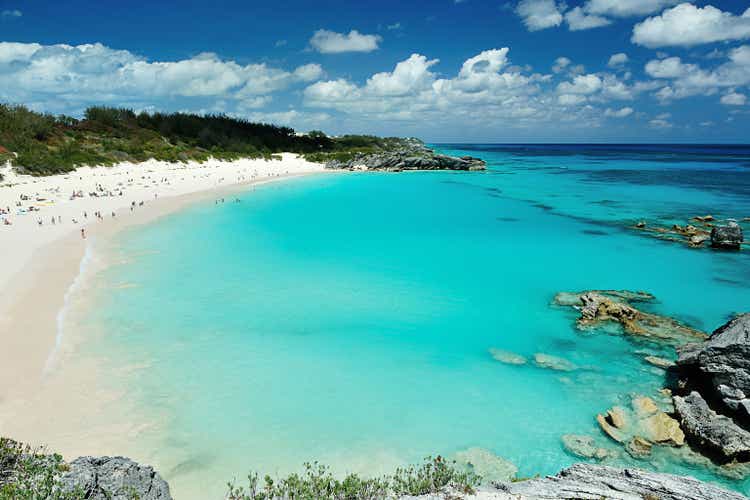
This is an abridged version of the full report published on Hoya Capital Income Builder Marketplace on March 23rd.
REIT Rankings: Hotels
Spring Break is back – for some, at least. Hotel REITs – one of just three property sectors in positive-territory this year – entered 2022 with positive fundamental momentum and reasons for optimism following four-straight years of underperformance. For the leisure industry, “two weeks to slow the spread” became two long years of operational struggles, and just as COVID headwinds faded, soaring energy prices and inflation have become new risk factors. Within the Hoya Capital Hotel REIT Index, we track the sixteen largest hotel REITs, which account for roughly $40 billion in market value.
Recent high-frequency data tracking hotel demand has been quite encouraging, consistent with solid quarterly reports from hotel REITs and contrasting with the gloomy attitude in consumer confidence surveys. TSA Checkpoint throughput data rebounded to 90% of pre-pandemic levels last week following a slow start to 2022 resulting from the Delta and Omicron waves of the COVID pandemic, which not only cooled demand but led to a surge in flight cancellations due to worker shortages. With COVID cases down more than 95% from their peak in mid-January, nearly all of the pandemic-era capacity restrictions have been eliminated while masking mandates appear to be on their last breaths following bipartisan agreement in the Senate and a renewed push from the travel industry this week to end the federal mandates.
Hotel occupancy – which is closely correlated with domestic airline travel – has exhibited similar resilience over the past two quarters and climbed back above the 20-Year average in late February and early March. According to data from STR, average hotel occupancy was within 8% of 2019-levels during the month of February while Average Daily Rates (“ADR”) were nearly 7% higher than 2019, resulting in an average Revenue Per Available Room (“RevPAR”) that was essentially even with pre-pandemic levels. AirDNA, which tracks travel demand, reported that the booking pace is 49% higher than 2021, and 26% higher than pre-pandemic 2019, and noted that rising fuel prices and geopolitical tensions are having the effect of pushing the demand mix from international trips towards domestic or North American destinations.
As discussed in our REIT Earnings Recap, upscale hotel REITs with a business-heavy mix – notably Pebblebrook (PEB), Host Hotels (HST), and Park Hotels (PK) – continue to report occupancy rates that are 15-30% below 2019-levels with RevPAR similarly lagging despite significant ADR inflation. On the other hand, hotel REITs focused on the lower end of the price spectrum with a more domestic leisure mix – most notably Apple Hospitality (APLE) – reported occupancy levels that were just 5% below pre-pandemic levels while resort-focused hotel REITs – notably Ryman Hospitality (RHP) and Braemar Hotels (BHR) – were able to offset much of their lagging occupancy with significantly higher average daily room rates.
Hotel REIT Stock Performance
Hotel REITs – along with the global leisure and tourism industry – were decimated in the early stages of the coronavirus pandemic, plunging by more than 65% between late February and early April 2020. The vaccine rollout in late 2020 and into early 2021 sparked a “reopening rotation” into many of the beaten-down COVID-sensitive sectors, but hotel REITs were unable to hold onto that outperformance throughout the year, ultimately ending 2021 with total returns of 19% compared to the 41% returns on the Equity REIT Index – marking their fourth-straight year of underperformance.
Buoyed by solid earnings reports and a broader rotation from growth-to-value across the global equity market, Hotel REITs are one of just three property sectors in positive territory this year. The Hoya Capital Hotel REIT Index – a market-cap weighted performance index – is higher by 2.0% so far in 2022, significantly outperforming the -10.1% decline from the Vanguard Real Estate ETF (VNQ) and the -6.6% decline from the S&P 500 ETF (SPY). The gains this year have been led – not coincidentally – by the four hotel REITs that resumed their dividends this year – Braemar Hotels, Apple Hospitality, Host Hotels, and Pebblebrook Hotels.
Deeper Dive into Hotel Industry
While the national trends are undoubtedly encouraging, it does hide the sharp divergence in the performance between Sunbelt-focused hotel markets and Coastal-focused hotel markets. Per recent CBRE data, the Top-10 performing markets in Q4 2021 were all in the Southeast or Southwest regions with average RevPAR of 14% above 2019-levels. The Bottom-10 markets were in Northeast or Northwest urban destinations with average RevPAR 37% below 2019-levels. Resort, interstate, and small-town hotel RevPARs all exceeded Q4 2019 levels in Q4 2021. Urban hotels remained at just 74% of pre-pandemic levels while airport hotels have recovered 86% of prior levels.
STR – the leading hotel industry research firm – upgraded their U.S. hotel forecast in late January, but raised caution about the impact of inflation, labor shortages, and unevenness across markets. STR now believes that average daily rates (ADR) will exceed their pre-pandemic level by 3% in 2022, while revenue per available room (RevPAR) is projected to be within 1% of pre-pandemic levels in 2022. STR commented, “The industry recaptured 83% of pre-pandemic RevPAR levels in 2021, and momentum is expected to pick up after a slow start to this year… looking beyond the first quarter, the backdrop for sustained travel recovery is strong,” citing an improving public health situation, sturdy labor market, and healthy consumer balance sheets.
Deeper Dive: Hotel REIT Economics
Hotel ownership is a tough, capital-intensive business even in the best of times. Generally, the companies that are ubiquitous with the hotel business Marriott (MAR), Hilton (HLT), Hyatt (H), Choice Hotels (CHH), and Extended Stay (STAY) – don’t actually own hotels but instead simply manage the hotel for the property owners. These hotel operators are typically structured as C-corporations and tend to operate with an “asset-light” operating model with higher margins and lower leverage. While REITs are effectively partnering with these hotel operators, the relationship with another emerging player – Airbnb (ABNB) – isn’t quite as friendly.
In recent years, hotel operators have been negatively impacted by a growing “shadow supply” of transient rooms offered through short-term home rental firms such as Airbnb. While we’re skeptical of Airbnb’s valuation – 2x the market capitalization of the entire hotel REIT sector combined – we are believers in the growing utilization of short-term home rentals. While short-term rentals represent less than 10% of available room nights on an average night, supply growth tends to swell considerably in response to high demand. Studies from STR and the BLS have found that short-term home rentals affect urban hotels most acutely, representing a source of “liquid supply” that compromises pricing power on critical compression nights.
In contrast to these hotel operators, hotel REITs operate under a relatively asset-heavy model and operate at considerably lower margins. We estimate that during “normal” times, hotel REITs operate at adjusted NOI margins of just 10-20%, the lowest in the REIT sector. Because of this operating profile, they assume a high degree of operating leverage and are highly sensitive to marginal changes in supply and demand conditions. Hotel REITs tend to be less nimble and have slower growth rates than C-corp hotel operators, but have historically paid a sizable dividend yield to investors.
Perhaps the only silver lining of the pandemic, the hotel development pipeline is finally showing signs of cooling after a half-decade of above-trend growth, and if the past recession is any indication, developers will be slow to resume activity even after the dust settles. Over the past several years, supply growth was most acute in the middle- and upper-quality segments, the segments most commonly owned by hotel REITs. On the other hand, supply growth has been nearly non-existent in the limited-service and economy segments, which have been two of the outperforming categories over the past several years.
Hotel REIT Dividend Yields
It’s tough to pay dividends if hotels are sitting half-empty. Generally speaking, 40-50% occupancy is needed to “keep the lights on” for hotel REITs. Once one of the highest-yielding REIT sectors, all 18 hotel REITs slashed their dividends in 2020 – accounting for a sizable percentage of the total dividend cuts last year – and despite the first wave of dividend resumptions this year, hotel REITs remain in the basement of the dividend yield tables. Hotel REITs pay an average dividend yield of just 0.6%, far below the 3.0% yield on the market-cap-weighted average and significantly below the 6.9% yield on the tier-weighted Hoya Capital High Dividend Yield Index.
While hotel REITs have generally been the among the last REITs to restore and/or raise their dividends, as anticipated last quarter, Apple Hospitality was indeed the first hotel REIT to materially restore its dividend, reinstating its monthly cash distribution of $0.05/share, representing a healthy dividend yield of 3.41%. A trio of other REITs also reinstated their dividends, but at nominal levels – Braemar Hotels reinstated its quarterly dividend at $0.01/share, Host Hotels reinstated its quarterly dividend at $0.03/share, while Park Hotels also reinstated its dividend at $0.01/share. While debt reduction will take precedence over dividend increases for the more highly-levered hotel REITs, we expect to see a gradual “normalization” in dividend payouts and should see hotel REITs again become a higher-yielding sector by 2023.
Takeaways: Solid Outlook, But Selectivity Key
Spring Break is back – but not for everyone. It continues to be a “Tale of Two Americas” for the hotel industry as Sunbelt and leisure-focused markets have substantially outperformed Coastal business-heavy markets – a trend that we expect to persist given the permanence of work-from-home trends and reduced corporate travel budgets. Recent high-frequency data has been encouraging, contrasting with the gloomy attitude in confidence surveys with TSA Checkpoint data rebounding to 90% of pre-pandemic levels last week but with risks still looming, selectivity within the sector remains critical.
For an in-depth analysis of all real estate sectors, be sure to check out all of our quarterly reports: Apartments, Homebuilders, Manufactured Housing, Student Housing, Single-Family Rentals, Cell Towers, Casinos, Industrial, Data Center, Malls, Healthcare, Net Lease, Shopping Centers, Hotels, Billboards, Office, Farmland, Storage, Timber, Prisons, and Cannabis.
Disclosure: Hoya Capital Real Estate advises two Exchange-Traded Funds listed on the NYSE. In addition to any long positions listed below, Hoya Capital is long all components in the Hoya Capital Housing 100 Index and in the Hoya Capital High Dividend Yield Index. Index definitions and a complete list of holdings are available on our website.



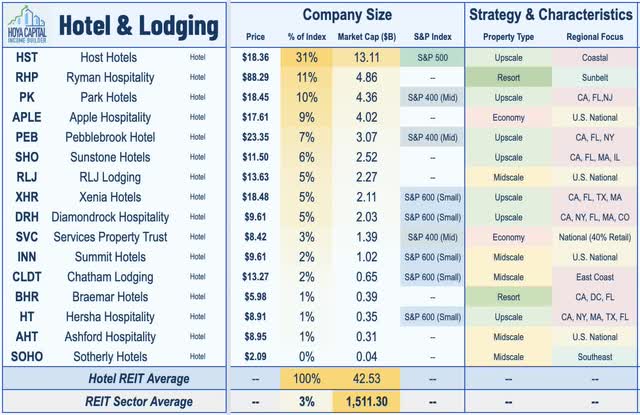
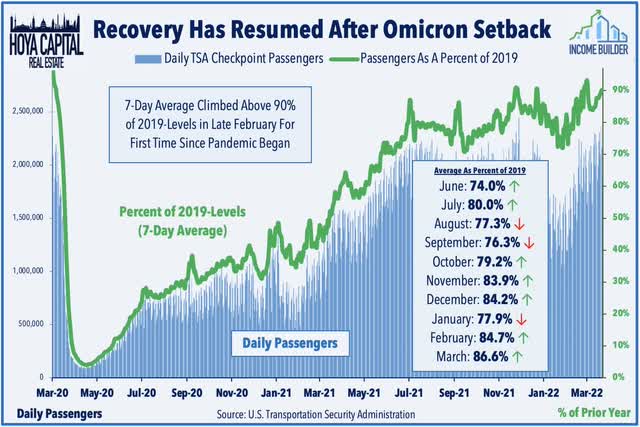
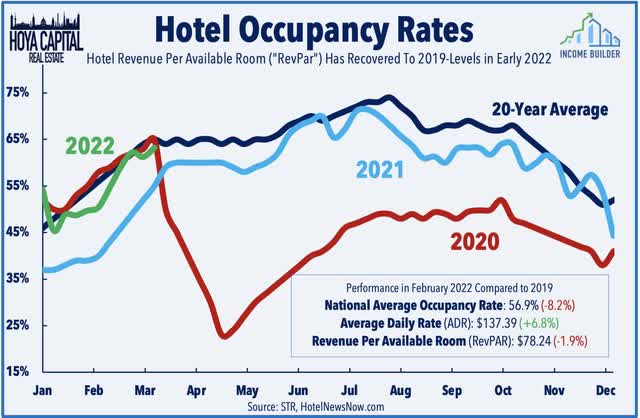
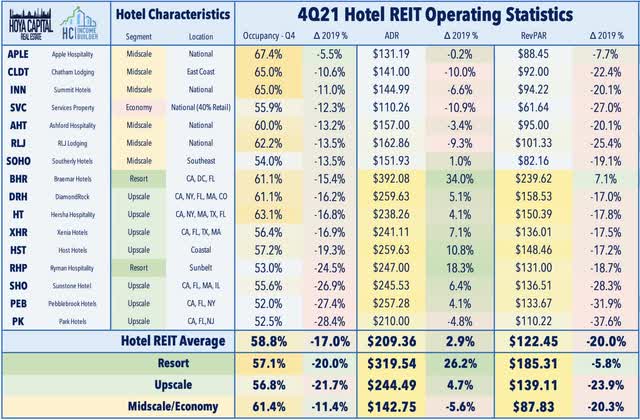
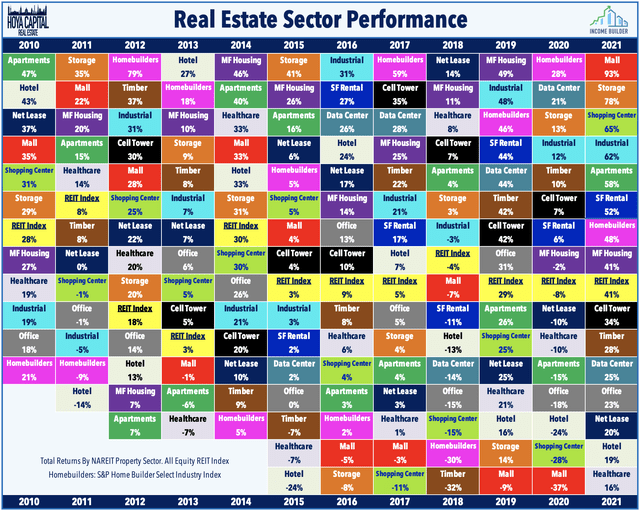
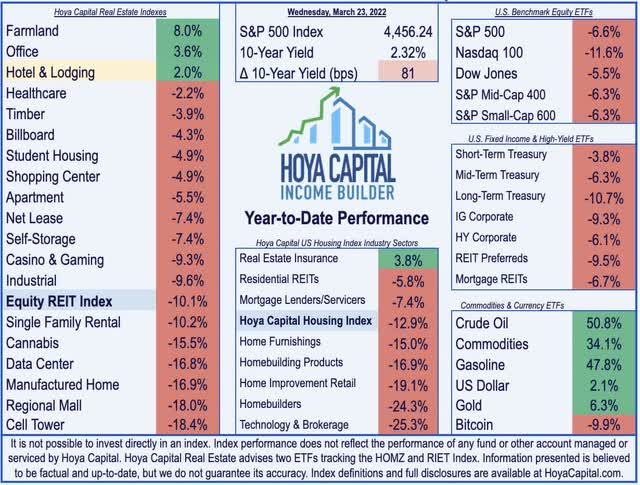
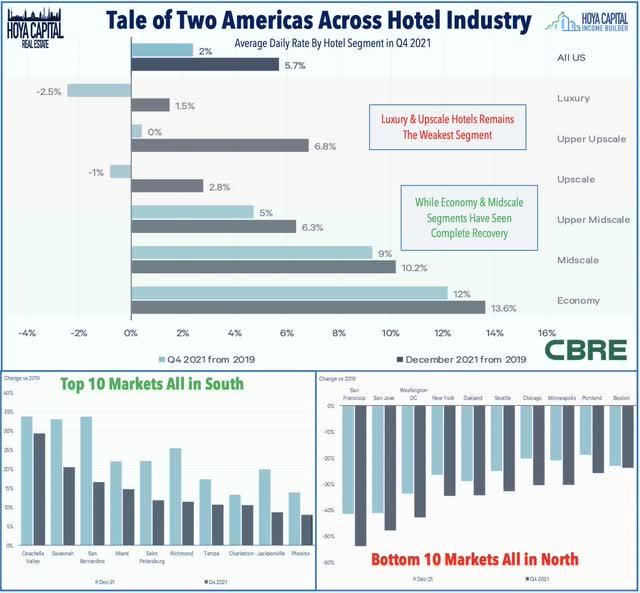
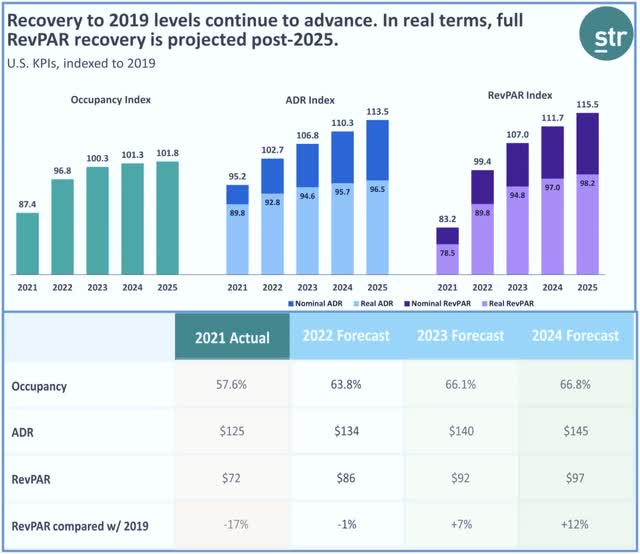
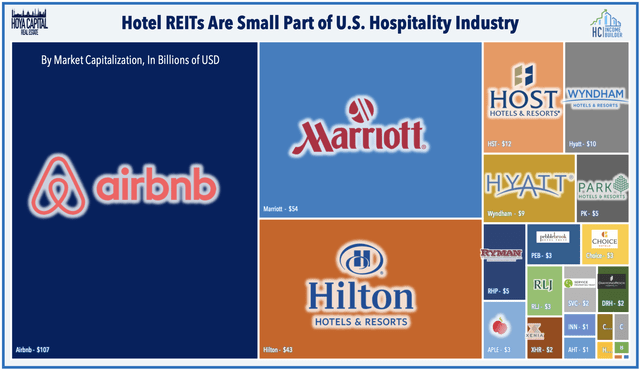
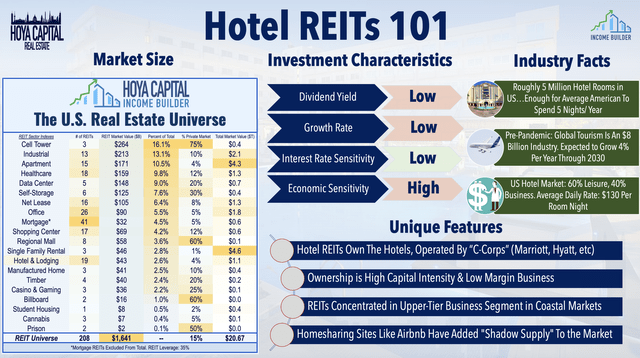
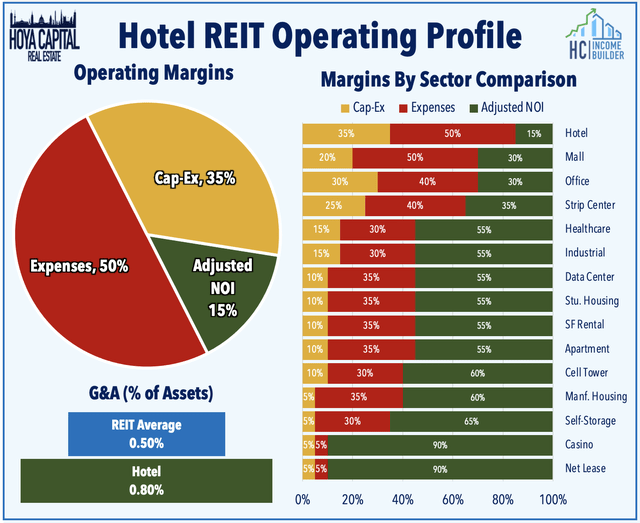
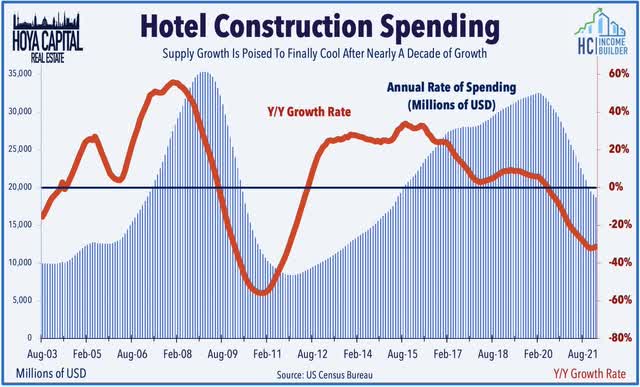
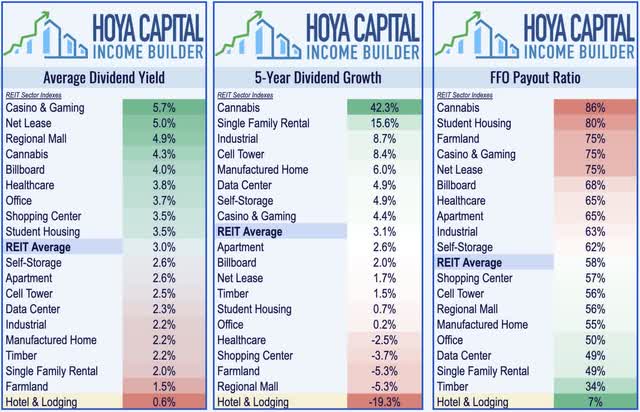
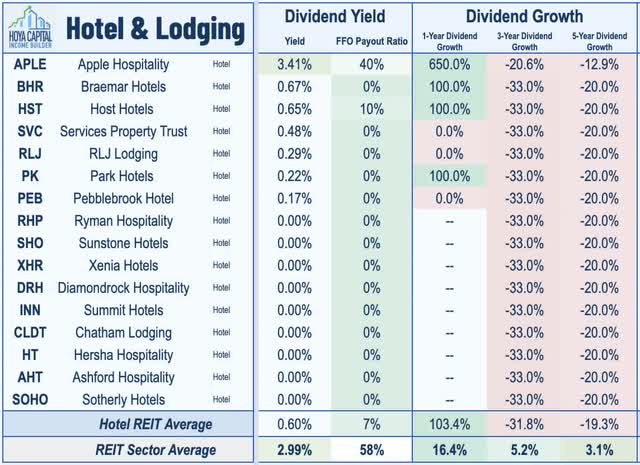
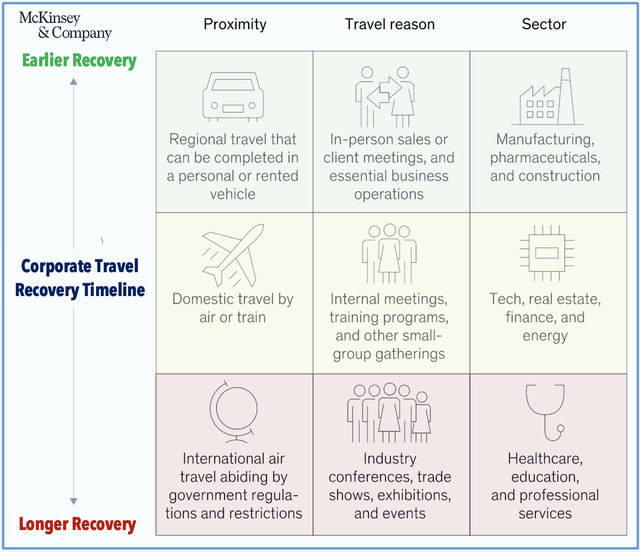
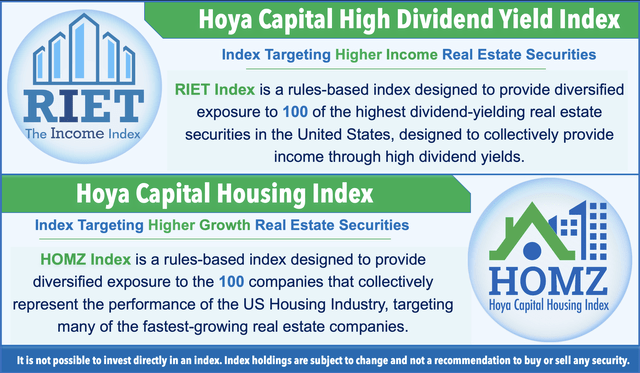
Be the first to comment